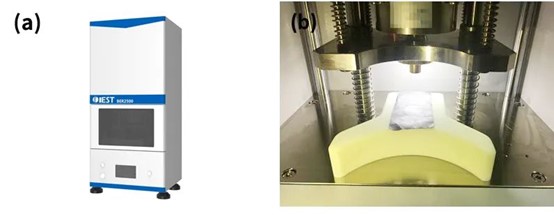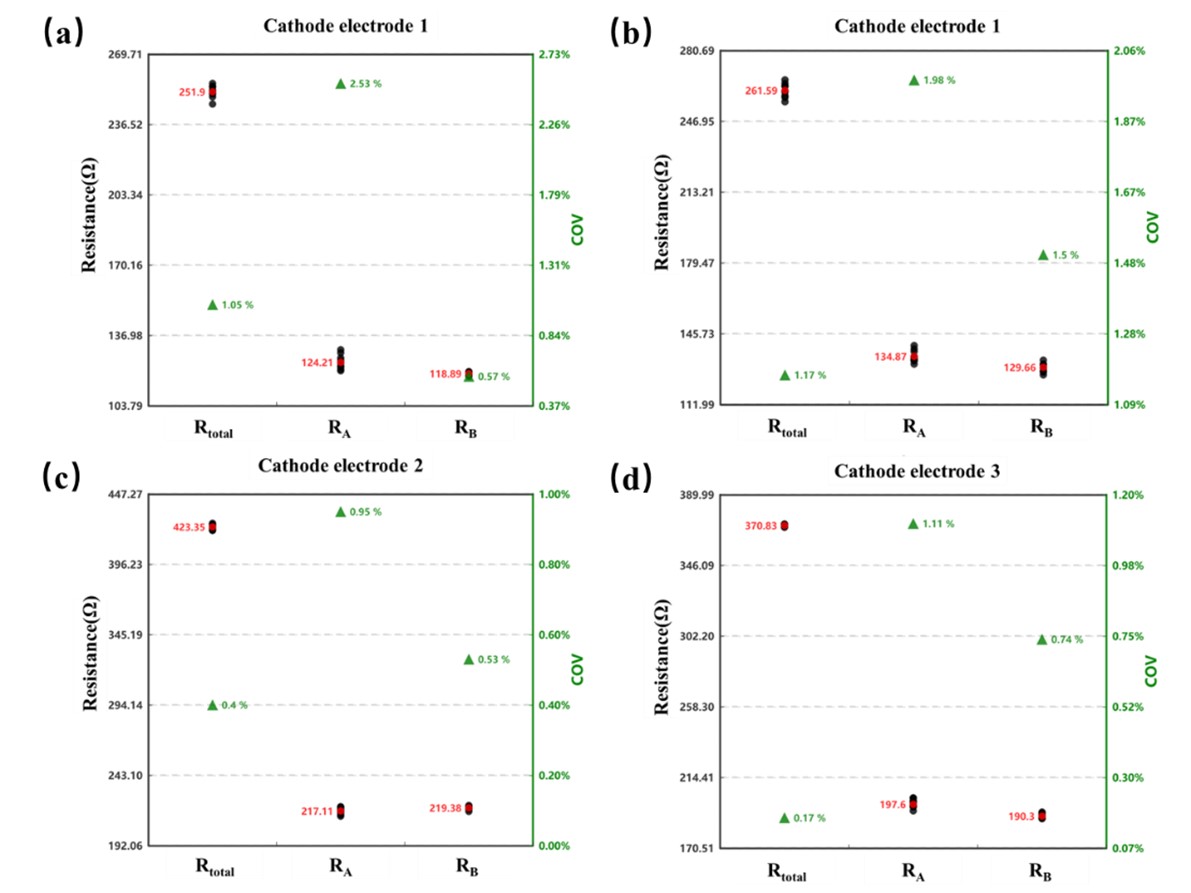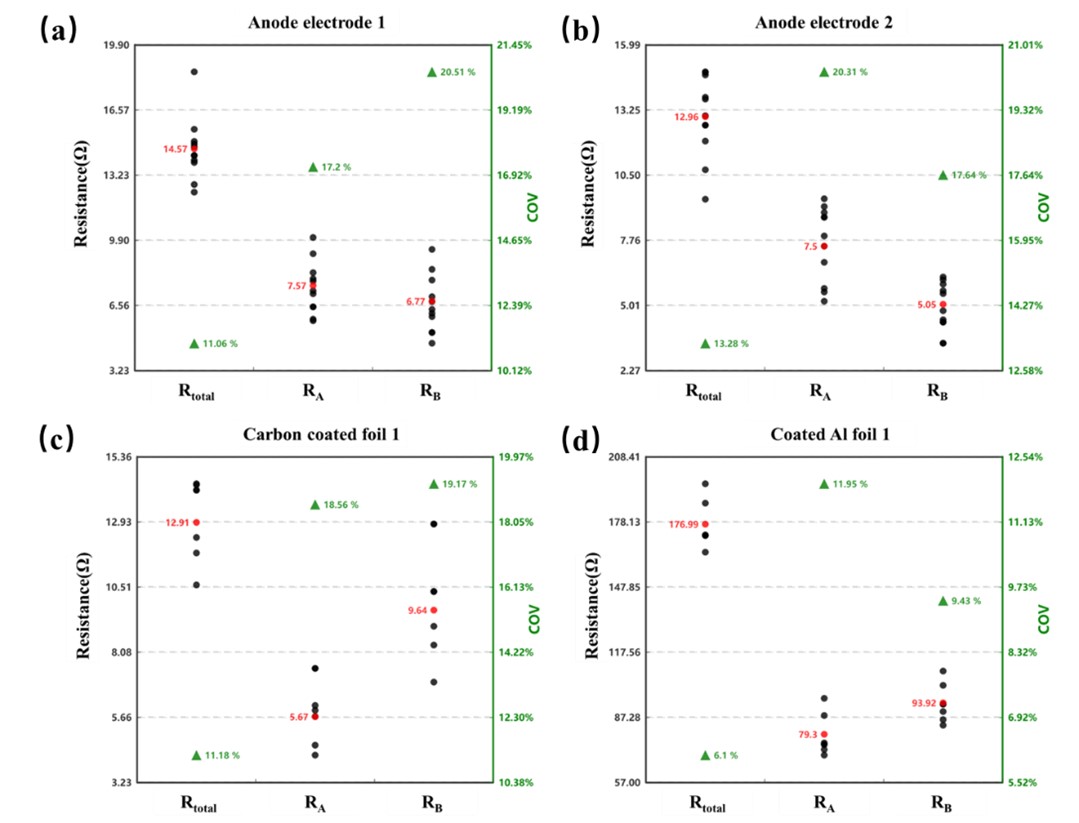Evaluation of Uniform Coating for Lithium Electrode Sheets
1. Preface
Lithium-ion batteries are a multi-component comprehensive system assembled from positive and negative electrode plates, separators and electrolytes. Among them, the positive and negative electrode plates are important components that provide and affect battery performance. When the battery is working, electrons and ions are transmitted in the pole pieces, and a series of chemical and electrochemical reactions occur. Therefore, the conductivity of the pole pieces and the uniformity of the conductive network are one of the important factors that affect the performance of the battery.
As for the electrode plate coating process, most battery electrode plates currently adopt a double-sided single-layer coating method. When the A-side coating is completed, the B-side coating is performed. With the development of the industry and the increasing demand for development, equipment manufacturers have developed double-sided coating machines, which are mainly fold-back processing. Coating dies are installed on both sides of the coating oven, first, coat side A on one side, dry it in the oven, then coat side B on the other side, dry it again in the second-layer oven, and then rewind it to complete the coating process on both sides. In recent years, two-sided simultaneous coating devices and technologies have also been developed. Compared with the existing single-sided coating and double-sided folding processing principles, this coating machine can achieve simultaneous coating and drying processes on both sides. Reduce the repetitive actions in the past and further improve the coating efficiency.
However, when using single-sided coating and double-sided fold-back coating, the slurry changes to a certain extent due to the difference in coating time, at the same time, differences between different batches of slurries, as well as differences caused by differences in baking time and space, will also be introduced, resulting in possible differences in the conductive uniformity of the AB surface; when using simultaneous coating technology on both sides, the position of the die relative to the foil is different, resulting in different flow states of the slurry and differences in coating uniformity on the AB side , therefore, an all-round evaluation of the uniformity of double-sided pole pieces is the key to quality monitoring of pole pieces. This article uses the in-situ pole piece AB surface resistance testing method independently developed by IEST to try to test the AB surface resistance of different positive and negative electrode materials, and finally clarified the measurement method that can effectively distinguish the difference, it can be used to evaluate the consistency of coating and rolling processes and assist in quality control during the battery cell production process.
2. Evaluate the Significance of AB Surface Coating Uniformity
The so-called coating uniformity refers to the consistency of the coating thickness or coating amount distribution in the coating area. The better the thickness of the coating or the consistency of the glue coating, the better the uniformity of the coating, and vice versa. Currently, there is no unified measurement index for coating uniformity. Battery cell companies usually use the deviation or percentage deviation of the coating thickness or coating amount at each point in a certain area relative to the average coating thickness or coating amount in the area, it can also be measured by the difference between the maximum and minimum coating thickness or coating amount in a certain area. Coating thickness is usually expressed in µm. However, the accuracy of thickness measurement is often unsatisfactory, resulting in poor discrimination in this method test. Therefore, battery cell companies urgently need an effective and rapid testing method to distinguish the coating uniformity of AB surfaces to improve battery performance and quality control capabilities.
2.1 Possible Reasons for AB Topcoat Differences
The coating process stage involves many process parameters, each of which has a different impact on the coated pole piece. For example, in the incoming slurry state, the electrode slurry consists of micron-sized active solid particles and nano-sized conductive agent particles suspended in a binder solution, solid particles are affected by gravity, Brownian motion, buoyancy, etc., and undergo motion processes such as settlement, random Brownian motion, agglomeration-deaggregation, therefore, the distribution state of the slurry conductive agent, active particles and the interaction between them will inevitably change, which will have an impact on the coating uniformity. Therefore, during the coating process, differences may occur in the length direction of the pole piece and the AB surface, such as inconsistent coating thickness or coating surface density, different distribution states of conductive agent and binder, etc.
At the same time, during the drying process of the electrode wet coating, the binder and conductive agent particles dissolved in the solvent may also migrate to the surface of the pole piece due to the solvent drying process, this causes the adhesive to float and the conductive agent to be distributed unevenly, especially after the A side is coated and dried, and then the B side is coated. When the B side drying parameters are the same as A side, due to the influence of the coating on surface A, the drying state and rate of the wet coating on surface B may be different, which can easily lead to differences in the uniformity of surface AB, in particular, the distribution state of the binder and conductive agent results in differences in the bonding strength and conductivity of the coating surface AB.
2.2 Impact of AB Top Coating Differences on Battery Performance
The difference in AB top coating will inevitably lead to poor battery consistency, especially the difference in AB top coating may lead to the following problems: (1) The actual N/P ratio of the AB side is different due to inconsistent surface density on both sides, or inconsistent active material utilization due to different conductivities, under conditions of high-rate charge-discharge or overcharge, uneven current distribution may occur, resulting in lithium precipitation on one side; (2) Due to the difference in conductivity between the AB side of the pole piece, the two sides of the battery have different lithiation degrees or different states of charge. During long-term cycling, different stresses accumulate on the AB side for a long time, resulting in cracks in the pole piece and coating peeling off and failure. Therefore, it is of great significance to evaluate the uniformity and difference of AB top coating.
3. Experimental Methods
Equipment Model: BER2500(IEST), Electrode Diameter 14mm. The equipment is shown in Figures 1(a) and 1(b).
Figure 1 (a) BER2500 appearance; (b) BER2500 structure diagram
Test Methods: In this article, the in-situ AB surface resistance test of the pole piece is carried out using the BER2500 independently developed by IEST, it is also equipped with a newly developed in-situ AB surface test function, which can output the total through-resistance, A-surface resistance and B-surface resistance of the pole piece in a single push-down test. Different positions of each pole piece are randomly selected for testing, and the coefficients of variation (COV) of the three resistances are calculated according to formula (1). The larger the COV, the worse the uniformity of the pole piece testing.
(1) Where n represents the number of tests, Ṝ represents the average value of all test resistances.
4. Data Analysis
Figure 2 shows the test results of the in-situ AB side of different double-sided coated positive electrode sheets under a pressure of 25MPa, of which 2(a) and 2(b) are two sets of repeatability tests for the positive electrode sheet 1. 2(c) and 2(d) are the tests of positive electrode plates 2 and 3 respectively, and each group selects 10 different sites for testing. The red dots in the figure are the average values of the 10 measurement points, and the green triangle marking points are the calculation results of the resistance coefficient of variation, or COV, of the 10 test points. The size of the COV value is the main reference basis for judging the uniformity of the electrode plate coating.
Judging from the test results of positive electrode piece 1, the resistance values of the A-side resistors in the two groups of tests are slightly larger than the resistance values of the B-side resistors, indicating that there is a difference in the coating uniformity between the A-side and B-side of the positive electrode material and the test results are basically consistent with the resistance of surface A + surface resistance of B ≈ total through resistance. Therefore, the resistance percentage of surface A and surface B of the pole piece in the total resistance of the pole piece can be calculated, at the same time, there is a small difference in the resistance and COV (both less than 5%) of the two sets of test results of pole piece 1, which can further illustrate that the coating uniformity of this pole piece is good.
Figures 2(c) and 2(d) show the test results of positive pole pieces 2 and 3 respectively. From the data, the resistance values of pole pieces 2 and 3 are both greater than pole piece 1, moreover, the coating uniformity of the AB surface of pole piece 2 is better than that of pole piece 3. The test results of both pole pieces are consistent with the resistance of surface A + surface resistance of B ≈ total penetration resistance.
Figure 2 (a) and (b) two in-situ AB surface test results of positive electrode piece 1, (c) and (d) are the in-situ AB surface test results of positive electrode piece 2 and positive electrode piece 3 respectively.
Figure 3(a) and Figure 3(b) show the in-situ AB surface test of two negative electrode plates with different process formulas. As shown, the resistance uniformity of the AB surface of negative electrode plate 1 is better, the AB surface resistance uniformity of the negative electrode piece 2 is relatively poor. Figure 3(c) and (d) show the AB surface resistance of carbon-coated aluminum foil and primer-coated aluminum foil. Both types of primer-coated aluminum foil show that the B-surface resistance is greater than the A-surface resistance.
Figure 3 (a) and (b) are respectively the in-situ AB surface test results of negative electrode piece 1 and negative electrode piece 2, (c) and (d) are respectively the in-situ AB surface test results of carbon-coated aluminum foil 1 and primer-coated aluminum foil 1.
5. Conclusion
This article uses IEST's BER series pole piece resistance meter, combined with the newly developed in-situ AB surface testing function, to effectively differentiate between the total penetration resistance, A-side resistance and B-side resistance of the pole piece. Judging from the test results of different pole pieces, this method can distinguish the two sides of the pole piece, further clarifying that this method can be used to evaluate the coating uniformity and the consistency of the rolling process, assist in the quality control and improvement of process methods in the battery production process.
6. References
[1] Lang Peng, Ren Jian. Thoughts on the development of key process equipment for lithium-ion power batteries in my country [J]. Special Equipment for the Electronic Industry, 2009, 38(11): 23-26.
[2] Song Lan, Xiong Ruoyu, Song Huaxiong, et al. Overview of multi-scale heterogeneity of lithium-ion batteries [J]. Energy Storage Science and Technology, 2022, 11(02): 2095-4239.2021.0409.




